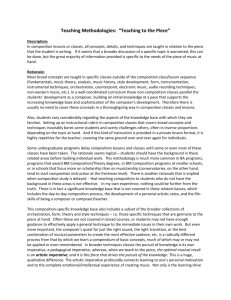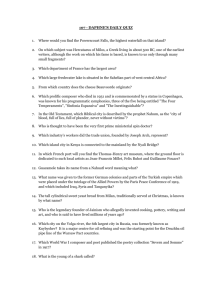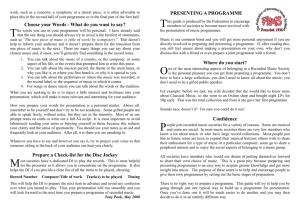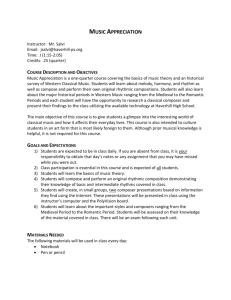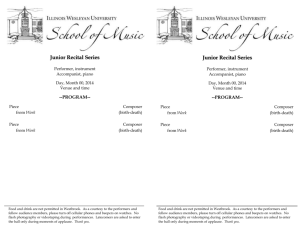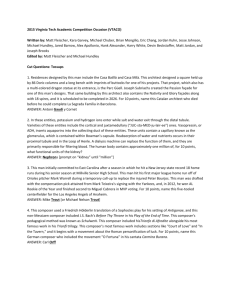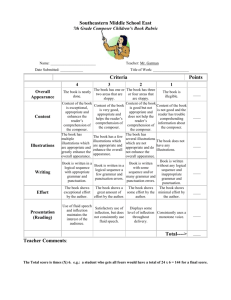PROPORTIONS AND THE COMPOSER` Music is a combinatorial art
advertisement
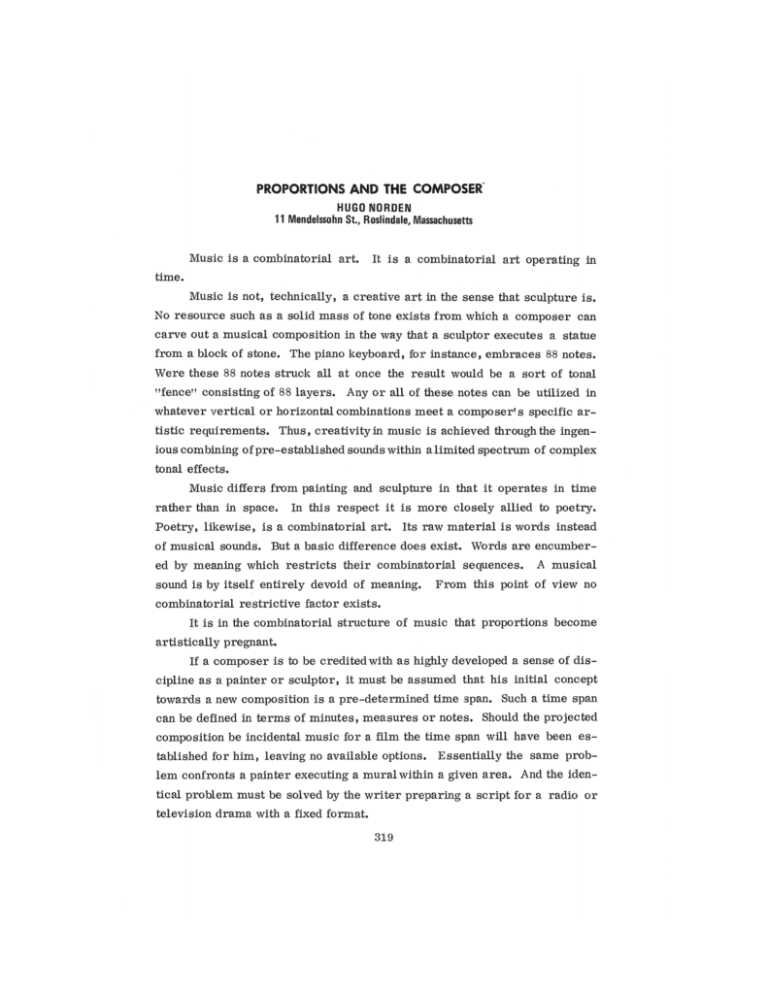
PROPORTIONS AND THE COMPOSER' HUGO WORDED 11 Mendelssohn St., Roslindale, SVIassaohusefts Music is a combinatorial a r t It is a combinatorial art operating in time. Music is not, technically., a creative art in the sense that sculpture is. No resource such as a solid mass of tone exists from which a composer can carve out a musical composition in the way that a sculptor executes a statue from a block of stone. The piano keyboard, for instance, embraces 88 notes. Were these 88 notes struck all at once the result would be a sort of tonal "fence" consisting of 88 layers. Any or all of these notes can be utilized in whatever vertical or horizontal combinations meet a composer 1 s specific a r tistic requirements. Thus, creativity in music is achieved through the ingenious combining of pre-established sounds within a limited spectrum of complex tonal effects. Music differs from painting and sculpture in that it operates in time rather than in space. In this respect it is more closely allied to poetry. Poetry, likewise, is a combinatorial art. Its raw material is words instead of musical sounds. But a basic difference does exist. Words are encumbered by meaning which restricts their combinatorial sequences. sound is by itself entirely devoid of meaning. A musical From this point of view no combinatorial restrictive factor exists. It is in the combinatorial structure of music that proportions become artistically pregnant. If a composer is to be credited with as highly developed a sense of discipline as a painter or sculptor, it must be assumed that his initial concept towards a new composition is a pre-determined time span. Such a time span can be defined in terms of minutes, measures or notes. Should the projected composition be incidental music for a film the time span will have been e s tablished for him, leaving no available options. Essentially the same problem confronts a painter executing a mural within a given area. And the identical problem must be solved by the writer preparing a script for a radio or television drama with a fixed format. 319 320 PROPORTIONS AND THE COMPOSER [Apr* Let us formulate a specific compositional problem; namely, a piano solo in a fairly quick tempo with a performance time of three minutes 9 twenty seconds. (So far nothing is being said about the content* mood, or style of the projected composition,,) First Decisions Tempo If the tempo is determined by a metronome setting of 96 for a quarternote, 96 quarter-notes per minute will make 320 quarter-notes in the composition. With four quarter-notes per measure, this tempo decision will r e sult in a composition 90 measures long. Herewith is established a definite commitment as to the outside dimensions of the projected compositional exercise. Second Decision; Principal Division of Form Resulting from First Decision For the beginner in the use of proportions a time span embracing 80 one-measure units presents an extremely elementary problem; merely partition it into two sections of 30 and 50 measures, respectively, achieving a simple 3:5 proportion. thereby Likewise, it can be split into 50 and 30 measures, thereby reversing the proportion. Thus, two simple form plans become available for artistic exploitation: 30 measures + 50 measures or 50 measures + 3 0 measures . Both of these forms can, of course, operate at once. One might determine the harmonic plan and the other the shape of the melody. A variety of h a r - monic and melodic applications of a proportion and its retrograde operating concurrently will inevitably occur to an enterprising and inventive composer. Third Decision: Subdivision of Overall Form Plan Resulting from the Second Decision At this level, the opportunities for ingenuity in the formal utilization of proportions is greatly increased. Several summation series can function concurrently in sophisticated time exploitation. For example, let us con- sider the extremely simple 30 + 50 measure form division developed under the second Decision. The opening 30-measure section can be subdivided into 1972] PROPORTIONS AND THE COMPOSER 321 18 + 12 m e a s u r e s In the Fibonacci p r o p o r t i o n of 3:2. On the o t h e r hand, the 5 0 - m e a s u r e section can be subdivided into 19 + 31 m e a s u r e s in the s e r i e s . 2 i 5 : 7 : 12^ : 1£ : 31 : 50 : 8 1 , e t c . T h u s , we now have a f o r m divided a s follows? 30 m e a s u r e s : 50 m e a s u r e s 18 + 12 19+31 Now the 12 m e a s u r e s of the opening 3 0 - m e a s u r e section r e l a t e s in the s a m e s e r i e s with the 1 9 - and 3 1 - m e a s u r e d i v i s i o n s of the closing 5 0 - m e a s u r e s e c tion. T h u s 9 the form i s evolving into m o r e complex r e l a t i o n s h i p s : 30 m e a s u r e s (3 : 5) 50 m e a s u r e s + 19 + 31 (3 : 2) 18 + 12 12 . In this light, the 12 m e a s u r e s at the end of the opening 3 0 - m e a s u r e section b e c o m e s a kind of ?! pivot !! r e l a t i n g the two different s u m m a t i o n s e r i e s . F o u r t h Decision: T r e a t i n g the subdivisions r e s u l t i n g from the t h i r d Decision Added f o r m a l sophistication can be achieved, and t h e r e b y g r e a t e r d i v e r sity o r complexity — w h i c h e v e r m a y be d e s i r e d , by subdividing the s e c t i o n s shown above a t the T h i r d Decision Into s m a l l e r units e i t h e r within the s e r i e s a l r e a d y in o p e r a t i o n o r by introducing a new series,, F o r I n s t a n c e , the initial 18 m e a s u r e s of the opening 3 0 - m e a s u r e section of the fundamentally b i n a r y f o r m l e n d s itself to a 7 + 11 o r 11 + 7 L u c a s division, and since 7 is a l so o p e r a t i v e in the s e r i e s mentioned under the T h i r d Decision, it would be quite e a s y to v i s u a l i z e how a s y s t e m a t i c a l l y r e c u r r i n g 7 - m e a s u r e phrase could a l m o s t a u t o m a t i c a l l y b e c o m e a c h a r a c t e r i s t i c feature in the design of the e n t i r e composition. The above i s an e x t r e m e l y e l e m e n t a r y p r o b l e m . tion i s equally e l e m e n t a r y . And the f o r m a l s o l u - Any c o m p o s e r with a bit of Imagination and 322 PROPORTIONS AND THE COMPOSER [Apr. structural ingenuity can think of many ways to divide and subsequently subdivide a time span of any given number of units. The second area in which proportions are useful is in the musical content of a given form as distributed in its various sections and subdivisions. Listed herewith are a few of the distribution possibilities: (1) kinds of harmonies (2) duration of harmonies (3) dissonance effects (4) rests and textures (5) registers and ranges (6) tonalities. To illustrate, under the Third Decision there is evolved a 12-measure subdivision that serves as a f?pivotn span that is common to two different summation series. If this is treated in terms of the series given under the Third Decision, it will be seen that it can be readily fragmented into 5 + 7. Some possibilities for exploiting this diminutive time span are (1) 5 major triads + 7 minor triads, or vice versa (2) 5 triads + 7 chords of the 7 , or vice versa (3) 5 measures containing two chords + 7 measures containing one chord, or vice versa (4) 5 measures having no discords + 7 measures containing discords, or vice versa, etc. This list of proportion possibilities can be extended as long as the composer has within his technique sufficient contrasting resources to originate additional complementary relationships. But, the above listings do not imply merely a one-dimensional division. Suppose a composer decides on five major and seven minor triads, utilizing two contiguous numbers in the series quoted under the Third Decision., Now comes the problem of selecting the horizontal arrangement of the five major and seven minor triads within the pre-determined twelve measures. Since this choice can be made only from the available number of placements, the process is one of selection rather than creativity. Herewith comes into play an intriguing aspect of the combinatorial art: namely, the systematic choice of effect placements within a time span. The Chorale harmonizations of Bach demonstrate r a r e genius in this respect. 1972] PROPORTIONS AND THE COMPOSER 323 The third area for proportion utilization is in the vertical arrangement of chordal and dissonance effects* Since the compositional exercise under consideration is a piano piece, it is idiomatic to maintain a large number of notes in motion for effective performance results* Suppose§ then 5 that in the first section of the piece that three notes were assigned to the left hand and five to the right. which arrangement can be inverted for contrast. In the second section* greater activity may be devised for increased i n t e r e s t This is obtainable by increasing the number of notes to* let us say* five and eight still in the Fibonacci series or to another series such as Lucas 1 four and seven. To heighten the organization further, the notes assigned to each hand could be proportionately divided between concords and discords* These are mere clues to a kind of organizational thinking that is available to composers,, It would* of course, be impractical to maintain such rigid internal organization throughout an entire composition, although there are movements in Bach where this does actually occur. It is more likely that such a plan would constitute a norm from which the composer can deviate. either systematically according to intentions or whimsically and freely* Above all 5 a systematic substructure must leave the composer unfettered and free* Any technique must be a help to the composer, never an obstacle to be conquered* Thus* it is quite possible that the proportion scheme from which a composition has its arising may never be definitely identified through the conventional academic processes* [Continued from page 318* ] FIBONACCI NUMBERS AND GEOMETRY geometrical ingenuity and thereby arriving simply and intuitively at algebraic relations involving Fibonacci numbers, Lucas numbers and general Fibonacci numbers* It appears that there is a considerable wealth of enrichment and discovery material in the general area of Fibonacci numbers as related to geometry* Reports of other types of geometric designs that lead to the discovery of Fibonacci formulas would be welcome by the Editor of the Elementary Section °^ ^ e Quarterly* •o-^-o-^

